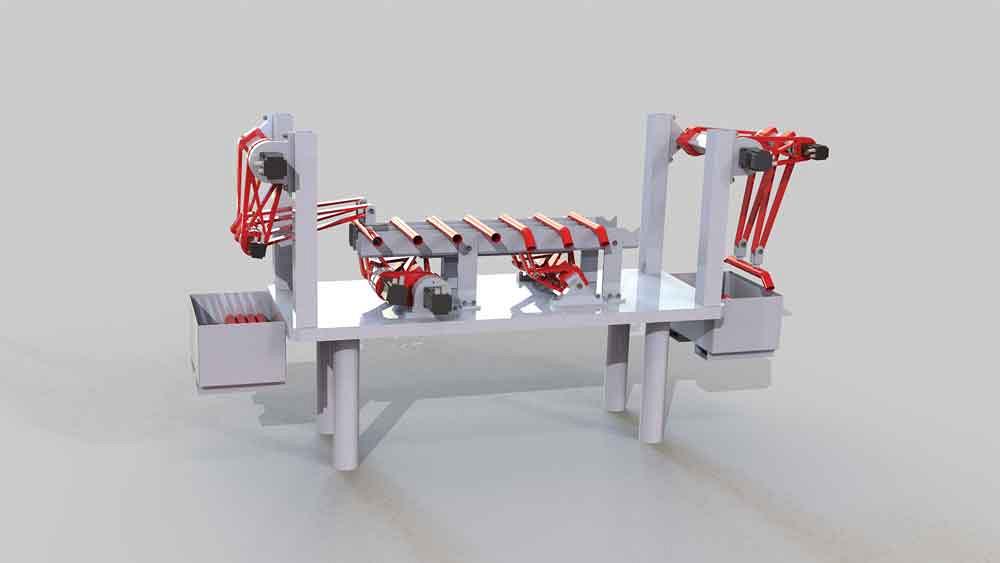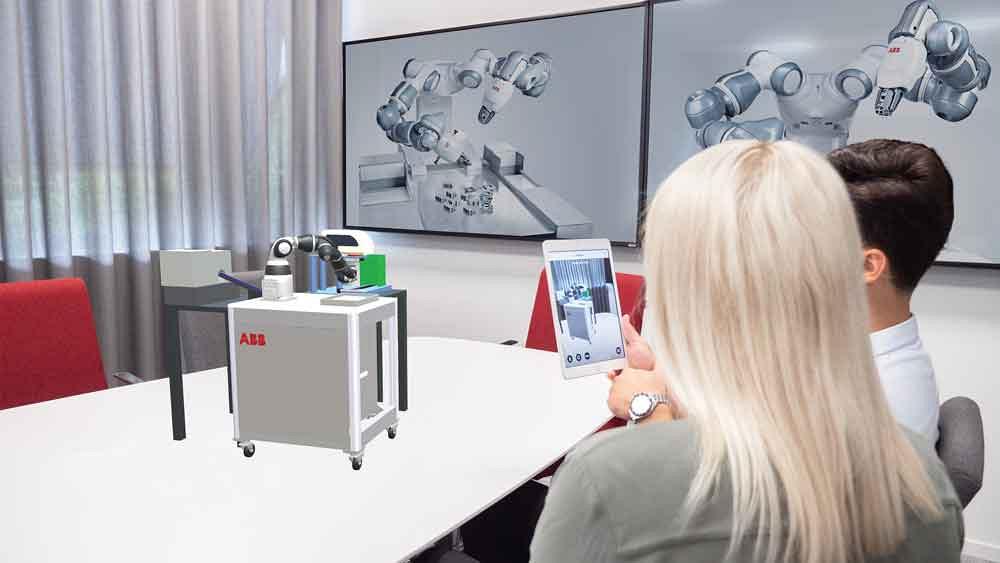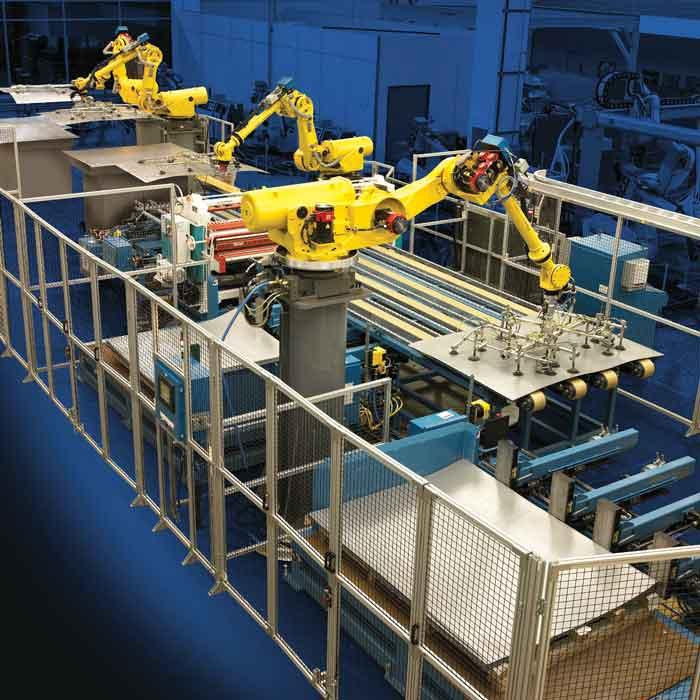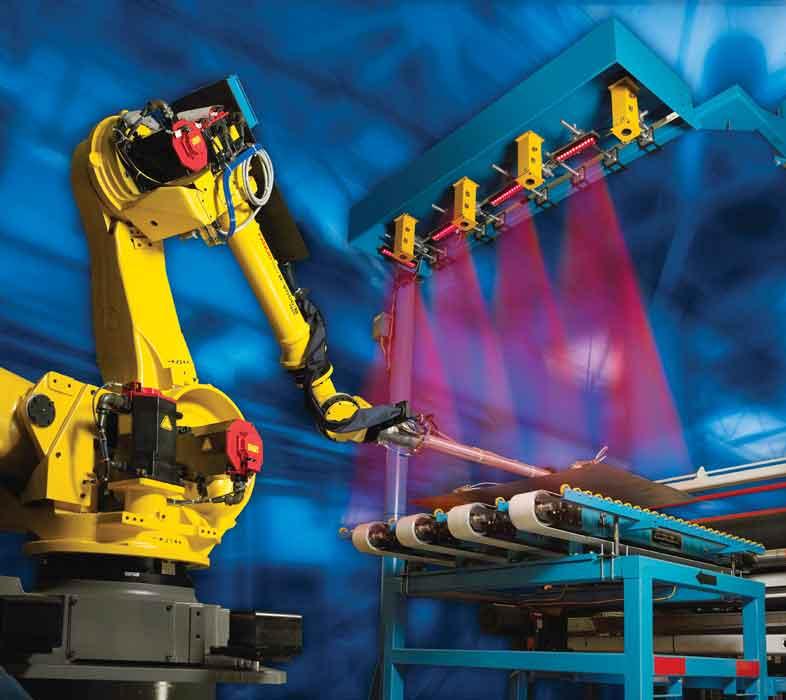Contributing editor
- FMA
- The Fabricator
- FABTECH
- Canadian Metalworking
Categories
- Additive Manufacturing
- Aluminum Welding
- Arc Welding
- Assembly and Joining
- Automation and Robotics
- Bending and Forming
- Consumables
- Cutting and Weld Prep
- Electric Vehicles
- En Español
- Finishing
- Hydroforming
- Laser Cutting
- Laser Welding
- Machining
- Manufacturing Software
- Materials Handling
- Metals/Materials
- Oxyfuel Cutting
- Plasma Cutting
- Power Tools
- Punching and Other Holemaking
- Roll Forming
- Safety
- Sawing
- Shearing
- Shop Management
- Testing and Measuring
- Tube and Pipe Fabrication
- Tube and Pipe Production
- Waterjet Cutting
Industry Directory
Webcasts
Podcasts
FAB 40
Advertise
Subscribe
Account Login
Search
Robots advance in the stamping shop
Automation upgrades improve manufacturing material handling, press tending
- By Kate Bachman
- October 8, 2020
- Article
- Automation and Robotics

3D vision systems give robots the capability to perform part inspections. Photo courtesy of ABB Robotics
For stamping manufacturers concerned about employee safety, an increasing skills gap, and pressure to meet higher throughput demand, robots may come to the rescue, according to KUKA Vice President Matt Jurczyszyn; DieBotics President Tim Launiere; FANUC Laser Business Development Manager Mike Sharpe; and ABB Robotics Global Product Manager-Press Automation Toni Roda.
“We have seen struggles to keep pace as well as with the physical demands of heavy parts,” said DieBotics’ Launiere. “Employee safety is compromised every time an employee has to touch the material.”
FANUC’s Sharpe agreed. “Many stampers are challenged with the ability to meet higher throughput demands and interpress exchange rates with more difficult environmental impacts to worker safety such as larger and more complex stampings that are difficult to handle.”
“The biggest challenge for stampers continues to be getting the maximum output of lines,” KUKA’s Jurczyszyn said. “This requires fast, linear, and stable part transfer from press to press—with high availability and low maintenance time. If the automation is not properly sized for the duty cycle, premature failure will occur.”
Furthermore, a high degree of flexibility is needed to drive as many parts as possible onto one line or separate them equally across several lines, he added.
“Our customers are telling us that they want the line to run faster; however, this causes issues with press wear and tear and racking pileups at the end of line,” Jurczyszyn said. “There comes a point where the operators at the end of the line cannot keep up.”
Other obstacles to increased output are that the materials and part sizes vary greatly. Large variances between the smallest part and the largest part, and multiple stacks on the pallet with nonferrous blanks and laser welded blanks, can causes problems.
Robotic material handling systems and technology have evolved to help meet these challenges, the companies contend.
Advances in robot technology for stamping applications include more intuitive user interfaces to simplify programming and use, 3D vision systems, improved sensing capabilities, and automatic tool changing. Other advances are improved speeds and the ability for one robot to access different presses and dies. In addition, intelligent technology software synchronizes actions and simulation programs for optimizing preinstallation.
One Controller for Multiple Operations
Multiple automation needs can be handled by a single control, Launiere said.
“Using our robotic walking beam transfer and two additional parallel-arm robots, the stamping process can be loaded and unloaded automatically. The process lends itself to any elongated workpiece that requires postprocessing, including stamped blanks.” The postprocessing could be stamping, machining, welding, seam locating and positioning, and inspection, Launiere added.
A built-in, user-programmable control using Boolean logic can handle the material handling as well as run additional tasks. “For example, an inspection camera at the end of the process can be monitored so defects are caught in real time. In-die sensors can be monitored and in-die mechanisms actuated using this feature.
Press-tending Robot Tends Multiple Presses
ABB recently launched its IRB 760PT flexible press-tending robot with 25% faster cycle times than linear press robots, according to ABB’s Roda.
“The robot is designed to eliminate the time, cost, and disruption associated with repurposing dedicated press-tending machines. It can be quickly adapted and reprogrammed to handle new products without the need for re-engineering,” Roda said. “Its 3.18-meter reach and a rotating seventh axis that allows parts to be reoriented between consecutive stamping operations mean that one robot can access different presses and dies.”
The press-tending robot’s servo tilting modules and two servo side shifting modules help handle large and medium-sized panels and special processes such as part reorientation, tilting (±30 degrees), and part separation (±300 mm).
In addition, to help eliminate the risk of potential interference between the robots and the press, the robot’s design was revised to reduce the working area in the robot’s third axis from 120 degrees to 80 degrees.
3D Vision Systems, Sensing
Sharpe said that the latest technology gives robots the capability to use 3D vision to adapt to loading/unloading press blanks or the flexibility to transfer stamped components into a laser cell. Robotic automation can be augmented by improved sensing capabilities, enabling robots to pick a stacked or accordion stack of stamped parts. “This capability reduces operator fatigue and the requirement for lift devices for large stamped components such as automotive door rings.”
Combining robotic systems with sophisticated sensors in vision systems enables them to quickly identify and easily adapt to deviations in part positions before loading the part in the press line, KUKA’s Jurczyszyn said.
Automatic Tool Changes
The ABB press-tending robot is enabled for fast automatic tool change, which can be performed in both the interpress floor area and in the bolster with the crossbar embarked together with the die, according to Roda.
KUKA’s automatic tool change can be verified through simulation, and if required, additional motions for the robot such as floor-mounted and ceiling-mounted transfer can be verified that way as well, Jurczyszyn said.

The rendering shows a patented robotic walking beam transfer with two patented parallel-arm robots that can automatically load and unload the stamping process. The process lends itself to any elongated workpiece that requires postprocessing, including stamped blanks, tubes, roll formed sections, and aluminum extrusions. Image courtesy of DieBotics
The robots can be equipped with tool storage on the line, he continued. “The tools are stored in such a way as to be available to the robot during die change. One way to have tool storage on the line is for the destack robot to use a universal tool.”
Intuitive Interface
Ease of programming and simplified electronics are making the automation less intimidating, DieBotics’ Launiere said.
FANUC is developing new and intuitive user interfaces and applications to make startup and programming easier for the user, according to Sharpe.
ABB’s StampWare includes a graphical programming wizard that decreases the time needed to train the operator and robot programmer and enables the robot system to be up and running quickly, Roda said.
Sychronized Software
These advances in robotic automation depend on intelligent technology software to manage all parts of the system, synchronizing their actions to maximize output and optimize production, Jurczyszyn said. This synchronization is especially important with servo presses. “Our customers are telling us that servo presses are becoming the norm,” he said. Servo press and automation synchronization software packages continue to be optimized.
FANUC developed PressSync software that couples an encoder to the press, allowing the robot to determine the appropriate timing to enter and close the press. The software eliminates the need for an expert programmer to tweak the anticipation timing to achieve optimal throughput, according to Sharpe.
The press-linking software brings several improvements, Sharpe said. A servo-controlled handling system enables robots to adjust press velocity so they can operate without the time-consuming stopping and re-accelerating in front of the press.
An early press start prevents unnecessary delay when exiting and closing the press. Encoders within the press allow the loading robot to follow parts distancing to optimize the unloading robot’s actions and prevent time lost from signal exchanging.
Blank Separation. More efficient methods of separating and controlling blanks during transfer operations have been developed, Jurczyszyn said.
Application Trends
Robotic technology has changed to adapt to the way robots are being used in stamping operations as well.

ABB Robotics’ RobotStudio AR viewer provides a quick way of visualizing where and how robotic automation can fit into a process from a smartphone or tablet. Photo courtesy of ABB Robotics
Laser Trimming, Transfer for Hot Stamping. “Hot stamping for lightweighting steels brings an entirely new set of challenges that are different than traditional stamping and requires die and process adjustments for each,” Jurczyszyn said.
FANUC has developed a new M-800iA/60 high-precision, high-speed laser processing robot with a new servo control system that increases the robot’s path accuracy for exacting applications. This capability makes it suitable for laser trimming of hot-stamped components. This robot can replace expensive multiaxis CNC machines used for that application.
Many robots and lasers can process a part simultaneously, making them well-suited for a large part such as a door ring, Jurczyszyn added.
Special-purpose. Special-purpose robots can better address specific needs, according to Launiere. “We are identifying specific needs and creating special-purpose automation to fill a need not easily serviced with a general robot.”
Complex Parts Handling. In addition to providing a more dynamic linear axis, tilting, and shifting axes, the handling systems have been optimized to handle more complex components. “Our Cobra handling systems have special carbon carriers that are flat and light, but still are constructed so that they are stable enough to support the materials handled in these applications,” Jurczyszyn said.
Modified for E-vehicles, Alternative Materials. The increased adoption of electric vehicles has prompted a shift from mild steel toward lighter-weight materials like aluminum, high-strength steels (HSS), and ultrahigh-strength steels (UHSS), Jurczyszyn said. This means that the handling equipment must be modified to work with each of the different materials, such as by the use of nonmagnetic destackers and double-blank detectors for aluminum.
Automation for Nesting. The drive to reduce material usage in production is pushing the need to nest blanks, DieBotics’ Launiere said. “The nested blanks do not lend themselves to progressive die carrying techniques. Therefore, automation is required. The automation could be as simple as a pneumatic shuttle for simple parts to full 3-axis transfer systems,” he said.
Hard Automation to Robots, Robots to Hard Automation
High-speed stamping robots for press-to-press operations are coming to market to match hard automation throughput. At the same time, some OEMs are moving from robots to hard automation to run tandem lines at 16 SPM, Jurczyszyn said.
Augmented Reality. ABB’s new RobotStudio AR viewer provides a quick way of visualizing where and how robotic automation can fit into a process using a smartphone or tablet. The viewer, part of the company’s PC-based RobotStudio offline programming software, can be used to test a model created in the software, enabling stampers to get an idea of the size and scale of a robot or robot cell and how it can be deployed on a factory floor to fit around existing production equipment.
The app overlays the model into the real-life production environment. Users can scale it to full size and rotate it through a variety of angles to achieve the best result and can watch the model in action. A timeline feature makes it possible to check the cycle time, then go to a certain point in the animation to find ways of enhancing performance or pinpointing a potential problem.

According to FANUC, the latest technology gives robots the capability to use 3D vision to adapt to loading and unloading press blanks or the flexibility to transfer stamped components. Photo courtesy of FANUC
The viewer allows stampers to test and refine options before they are implemented. New product lines can be installed faster and ramped up to full speed without surprises during commissioning, Roda said.
“Many stamping companies are looking to implement some form of robotic automation but are unsure of where to start,” Roda said. “RobotStudio is an intuitive digital tool that helps simplify the installation and use of robots.”
About the Author

Kate Bachman
815-381-1302
Kate Bachman is a contributing editor for The FABRICATOR editor. Bachman has more than 20 years of experience as a writer and editor in the manufacturing and other industries.
Related Companies
subscribe now

The Fabricator is North America's leading magazine for the metal forming and fabricating industry. The magazine delivers the news, technical articles, and case histories that enable fabricators to do their jobs more efficiently. The Fabricator has served the industry since 1970.
start your free subscription- Stay connected from anywhere

Easily access valuable industry resources now with full access to the digital edition of The Fabricator.

Easily access valuable industry resources now with full access to the digital edition of The Welder.

Easily access valuable industry resources now with full access to the digital edition of The Tube and Pipe Journal.
- Podcasting
- Podcast:
- The Fabricator Podcast
- Published:
- 04/16/2024
- Running Time:
- 63:29
In this episode of The Fabricator Podcast, Caleb Chamberlain, co-founder and CEO of OSH Cut, discusses his company’s...
- Trending Articles
AI, machine learning, and the future of metal fabrication

Employee ownership: The best way to ensure engagement

Steel industry reacts to Nucor’s new weekly published HRC price

Dynamic Metal blossoms with each passing year

Metal fabrication management: A guide for new supervisors

- Industry Events
16th Annual Safety Conference
- April 30 - May 1, 2024
- Elgin,
Pipe and Tube Conference
- May 21 - 22, 2024
- Omaha, NE
World-Class Roll Forming Workshop
- June 5 - 6, 2024
- Louisville, KY
Advanced Laser Application Workshop
- June 25 - 27, 2024
- Novi, MI



























